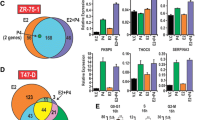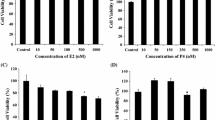Abstract
The purpose of this article is to determine the tumorigenic potential of estradiol treatment (E2) when combined with either progesterone (P4) or medroxyprogesterone acetate (MPA) in normal luminal human breast cells (HBE) and in human breast cancer cells (T47-D, MCF-7). Proliferation profiles were evaluated, along with the gene transactivation activity between the progesterone and glucocorticoid receptors (PR, GR) in HBE, T47-D, and MCF-7 cells treated by E2 + P4 or E2 + MPA. High throughput transcriptome analysis was performed on RNA from HBE cells treated by E2, E2 + MPA and E2 + P4. GR content was analyzed in normal breast cells as well. In HBE cells, E2 + P4 treatment was antiproliferative and promoted cellular differentiation. In contrast, E2 + MPA displayed mitogenic, antiapoptotic effects in HBE cells and did not influence cellular differentiation. The effect of P4 and MPA on cell proliferation was, however, variable in breast cancer cells. In cells containing GR or/and PR, MPA decreased proliferation whereas P4 antiproliferative effect needed the presence of PR. In HBE cells, the regulation of genes by E2 + P4, and E2 + MPA was significantly different, particularly in cell proliferation and cell death gene families. Further analysis revealed a modulation of the glucocorticoid receptor gene expression pathway by E2 + MPA. Predominant MPA glucocorticoid activity in normal and breast cancer cells was demonstrated using a glucocorticoid antagonist and the down-regulation of the GR by RNA interference. In normal luminal breast cells and in breast cancer cells, P4 and MPA combined with E2 treatment have opposing mitogenic effects due to GR. The consequences of MPA glucocorticoid potencies as well as the importance of GR in breast tissue merit a reappraisal.








Similar content being viewed by others
References
Rossouw JE, Anderson GL, Prentice RL et al (2002) Risks and benefits of estrogen plus progestogen in healthy postmenopausal women: principal results From the Women’s Health Initiative randomized controlled trial. JAMA 288:321–333
Fournier A, Berrino F, Clavel-Chapelon F (2008) Unequal risks for breast cancer associated with different hormone replacement therapies: results from the E3N cohort study. Breast Cancer Res Treat 107:103–111
Bakken K, Fournier A, Lund E et al (2011) Menopausal hormone therapy and breast cancer risk: Impact of different treatments. The European prospective investigation into cancer and nutrition (EPIC). Int J Cancer 128:144–156
Calle EE, Feigelson HS, Hildebrand JS et al (2009) Postmenopausal hormone use and breast cancer associations differ by hormone regimen and histologic subtype. Cancer 115:936–945
Sitruk-Ware R (2008) Pharmacological profile of progestogens. Maturitas 61:151–157
Wood CE, Register TC, Lees CJ et al (2007) Effects of estradiol with micronized progesterone or medroxyprogesterone acetate on risk markers for breast cancer in postmenopausal monkeys. Breast Cancer Res Treat 101:125–134
Wood CE, Register TC, Cline JM (2009) Transcriptional profiles of progestogen effects in the postmenopausal breast. Breast Cancer Res Treat 114:233–242
Wan Y, Nordeen SK (2002) Overlapping but distinct gene regulation profiles by glucocorticoids and progestogens in human breast cancer cells. Mol Endocrinol 16:1204–1214
Hermes GL, Delgado B, Tretiakova M et al (2009) Social isolation dysregulates endocrine and behavioral stress while increasing malignant burden of spontaneous mammary tumors. Proc Natl Acad Sci USA 106:22393–22398
Moutsatsou P, Papavassiliou AG (2008) The glucocorticoid receptor signalling in breast cancer. J Cell Mol Med 12:145–163
TKaSR Amsterdam A (2002) Cell-specific regulation of apoptosis by glucocorticoids: implication to their anti-inflammatory action. Biochem Pharmacol 64:843–850
Lippman M, Bolan G, Huff K (1976) The effects of glucocorticoids and progesterone on hormone-responsive human breast cancer in long-term tissue culture. Cancer Res 36:4602–4609
Belova L, Delgado B, Kocherginsky M, Melhem A, Olopade OI, Conzen SD (2009) Glucocorticoid receptor expression in breast cancer associates with older patient age. Breast Cancer Res Treat 116:441–447
Malet C, Gompel A, Yaneva H et al (1991) Estradiol and progesterone receptors in cultured normal human breast epithelial cells and fibroblasts: immunocytochemical studies. J Clin Endocrinol Metab 73:8–17
Malet C, Gompel A, Spritzer P et al (1988) Tamoxifen and hydroxytamoxifen isomers versus estradiol effects on normal human breast cells in culture. Cancer Res 48:7193–7199
Cavailles V, Gompel A, Portois MC et al (2002) Comparative activity of pulsed or continuous estradiol exposure on gene expression and proliferation of normal and tumoral human breast cells. J Mol Endocrinol 28:165–175
Rochefort H (1995) Oestrogen- and anti-oestrogen-regulated genes in human breast cancer. Ciba Found Symp 191:254–265 (discussion 265–258)
May FE, Johnson MD, Wiseman LR et al (1989) Regulation of progesterone receptor mRNA by oestradiol and antioestrogens in breast cancer cell lines. J Steroid Biochem 33:1035–1041
Westley B, May FE, Brown AM et al (1984) Effects of antiestrogens on the estrogen-regulated pS2 RNA and the 52- and 160-kilodalton proteins in MCF7 cells and two tamoxifen-resistant sublines. J Biol Chem 259:10030–10035
Gompel A, Malet C, Spritzer P et al (1986) Progestogen effect on cell proliferation and 17 beta-hydroxysteroid dehydrogenase activity in normal human breast cells in culture. Journal Clin Endocrinol Metab 63:1174–1180
Svensson LO, Johnson SH, Olsson SE (1994) Plasma concentrations of medroxyprogesterone acetate, estradiol and estrone following oral administration of Klimaxil, Trisequence/Provera and Divina. A randomized, single-blind, triple cross-over bioavailability study in menopausal women. Maturitas 18:229–238
Somai S, Chaouat M, Jacob D et al (2003) Antiestrogens are pro-apoptotic in normal human breast epithelial cells. Int J Cancer 105:607–612
Chalbos D, Joyeux C, Galtier F et al (1992) Progestogen-induced fatty acid synthetase in human mammary tumors: from molecular to clinical studies. J Steroid Biochem Mol Biol 43:223–228
Kuhajda FP (2006) Fatty acid synthase and cancer: new application of an old pathway. Cancer Res 66:5977–5980
Esslimani-Sahla M, Thezenas S, Simony-Lafontaine J, Kramar A, Lavaill R, Chalbos D, Rochefort H (2007) Increased expression of fatty acid synthase and progesterone receptor in early steps of human mammary carcinogenesis. Int J Cancer 120:224–229
Poulin R, Baker D, Poirier D et al (1991) Multiple actions of synthetic ‘progestogens’ on the growth of ZR-75-1 human breast cancer cells: an in vitro model for the simultaneous assay of androgen, progestogen, estrogen, and glucocorticoid agonistic and antagonistic activities of steroids. Breast Cancer Res Treat 17:197–210
Karst H, de Kloet ER, Joels M (1997) Effect of ORG 34116, a corticosteroid receptor antagonist, on hippocampal Ca2+ currents. Eur J Pharmacol 339:17–26
Attardi BJ, Burgenson J, Hild SA et al (2004) In vitro antiprogestational/antiglucocorticoid activity and progestogen and glucocorticoid receptor binding of the putative metabolites and synthetic derivatives of CDB-2914, CDB-4124, and mifepristone. J Steroid Biochem Mol Biol 88:277–288
Lien HC, Lu YS, Cheng AL, Chang WC, Jeng YM, Kuo YH, Huang CS, Chang KJ, Yao YT (2006) Differential expression of glucocorticoid receptor in human breast tissues and related neoplasms. J Pathol 209:317–327
Conde IP, FraileB Lucio J, Arenas MI (2008) Glucocorticoid receptor changes its cellular location with breast cancer development. Histol Histopathol 23:77–85
Sorlie T, Perou CM, Tibshirani R et al (2001) Gene expression patterns of breast carcinomas distinguish tumor subclasses with clinical implications. Proc Natl Acad Sci USA 98:10869–10874
Perou CM, Sorlie T, Eisen MB et al (2000) Molecular portraits of human breast tumours. Nature 406:747–752
Richardson AL, Wang ZC, De Nicolo A et al (2006) X chromosomal abnormalities in basal-like human breast cancer. Cancer Cell 9:121–132
Boersma BJ, Reimers M, Yi M et al (2008) A stromal gene signature associated with inflammatory breast cancer. Int J Cancer 122:1324–1332
Bonnefoi H, Potti A, Delorenzi M et al (2007) Validation of gene signatures that predict the response of breast cancer to neoadjuvant chemotherapy: a substudy of the EORTC 10994/BIG 00-01 clinical trial. Lancet Oncol 8:1071–1078
Chin K, DeVries S, Fridlyand J et al (2006) Genomic and transcriptional aberrations linked to breast cancer pathophysiologies. Cancer Cell 10:529–541
Loi S, Haibe-Kains B, Desmedt C et al (2007) Definition of clinically distinct molecular subtypes in estrogen receptor-positive breast carcinomas through genomic grade. J Clin Oncol 25:1239–1246
Loi S, Haibe-Kains B, Desmedt C et al (2008) Predicting prognosis using molecular profiling in estrogen receptor-positive breast cancer treated with tamoxifen. BMC Genomics 9:239
Sotiriou C, Neo SY, McShane LM et al (2003) Breast cancer classification and prognosis based on gene expression profiles from a population-based study. Proc Natl Acad Sci USA 100:10393–10398
Yu K, Ganesan K, Miller LD et al (2006) A modular analysis of breast cancer reveals a novel low-grade molecular signature in estrogen receptor-positive tumors. Clin Cancer Res 12:3288–3296
Gompel A, Somaï S, Chaouat M et al (2000) Hormonal regulation of apoptosis in breast cells and tissues. Steroids 65:593–598
Foidart JM, Colin C, Denoo X et al (1998) Estradiol and progesterone regulate the proliferation of human breast epithelial cells. Fertil Steril 69:963–969
Hofseth LJ, Raafat AM, Osuch JR et al (1999) Hormone replacement therapy with estrogen or estrogen plus medroxyprogesterone acetate is associated with increased epithelial proliferation in the normal postmenopausal breast. J Clin Endocrinol Metab 84:4559–4565
Wintermantel TM, Bock D, Fleig V, Greiner EF, Schutz G (2005) The epithelial glucocorticoid receptor is required for the normal timing of cell proliferation during mammary lobuloalveolar development but is dispensable for milk production. Mol Endocrinol 19:340–349
Leo JC, Guo C, Woon CT et al (2004) Glucocorticoid and mineralocorticoid cross-talk with progesterone receptor to induce focal adhesion and growth inhibition in breast cancer cells. Endocrinology 145:1314–1321
Szapary D, Song LN, He Y et al (2008) Differential modulation of glucocorticoid and progesterone receptor transactivation. Mol Cell Endocrinol 283:114–126
Foidart JM, Desreux J, Pintiaux A et al (2007) Hormone therapy and breast cancer risk. Climacteric 10(Suppl 2):54–61
Acknowledgments
We thank Drs. Michèle Resche-Rigon (HRA Pharma, Paris) for helpful discussions and providing the anti-progestogen VA-2914, Steve K. Nordeen (University of Colorado, Denver) for kindly providing sequences of IEX-1 primers, Helenius J. Kloosterboer (Organon, Part of Shering-Plough, Oss) for providing antiglucocorticoid ORG-34116, Ramiro Castro Urology Medical Director (GSK, UK) for the generous gift of Dutasteride and Sylvie Dumont for her excellent technical assistance in immunohistochemistry experiments. We are grateful to Niel Insdorf for his kind help in editing the manuscript. This research was supported by grants from INSERM-UPMC, the Association pour la Recherche sur le Cancer, HRA Pharma and Novartis (France). Aurélie Courtin was a recipient of a grant from the Association pour la Recherche sur le Cancer, Laudine Communal is a recipient for a grant from HRA Pharma. Myriam Vilasco is a recipient of a post-doc fellowship (Institut National Contre le Cancer-INCA). Daniela Taverna was supported by grants from the University of Torino (Local Research Funding 2007/DT, 2008/DT), Regione Piemonte Ricerca Scientifica Applicata (CIPE2004/DT) and Compagnia di San Paolo, Torino. Daniela Cimino is a fellow of the Regione Piemonte.
Author information
Authors and Affiliations
Corresponding author
Electronic supplementary material
Below is the link to the electronic supplementary material.
10549_2011_1394_MOESM1_ESM.ppt
Supplementary Figure 1: Validation of HBE cell model: PR and ER protein expression. Immunocytochemistry of PR (left) and ER (right) and negative control (NC) (a) (original magnification ×200). Characterization of luminal epithelial cells using expression of CK18 detected by immunofluorescence (b) (original magnification ×600). Comparison of PR and ER mRNA amounts in normal and breast cancer cells by RT-qPCR (c). Results are expressed in cycle threshold (Ct) values (mean ± SEM, n = 5 (HBE), n = 3 (MCF-7 and T47-D))
Rights and permissions
About this article
Cite this article
Courtin, A., Communal, L., Vilasco, M. et al. Glucocorticoid receptor activity discriminates between progesterone and medroxyprogesterone acetate effects in breast cells. Breast Cancer Res Treat 131, 49–63 (2012). https://doi.org/10.1007/s10549-011-1394-5
Received:
Accepted:
Published:
Issue Date:
DOI: https://doi.org/10.1007/s10549-011-1394-5




